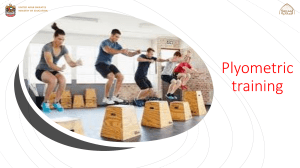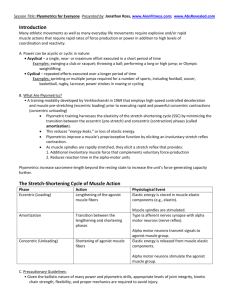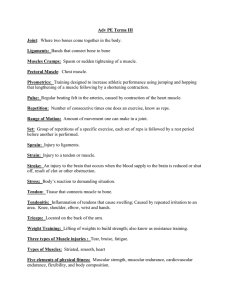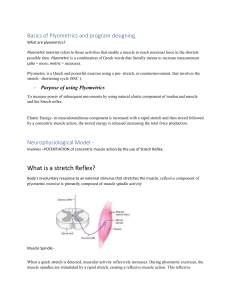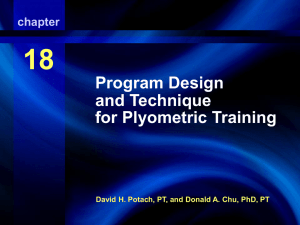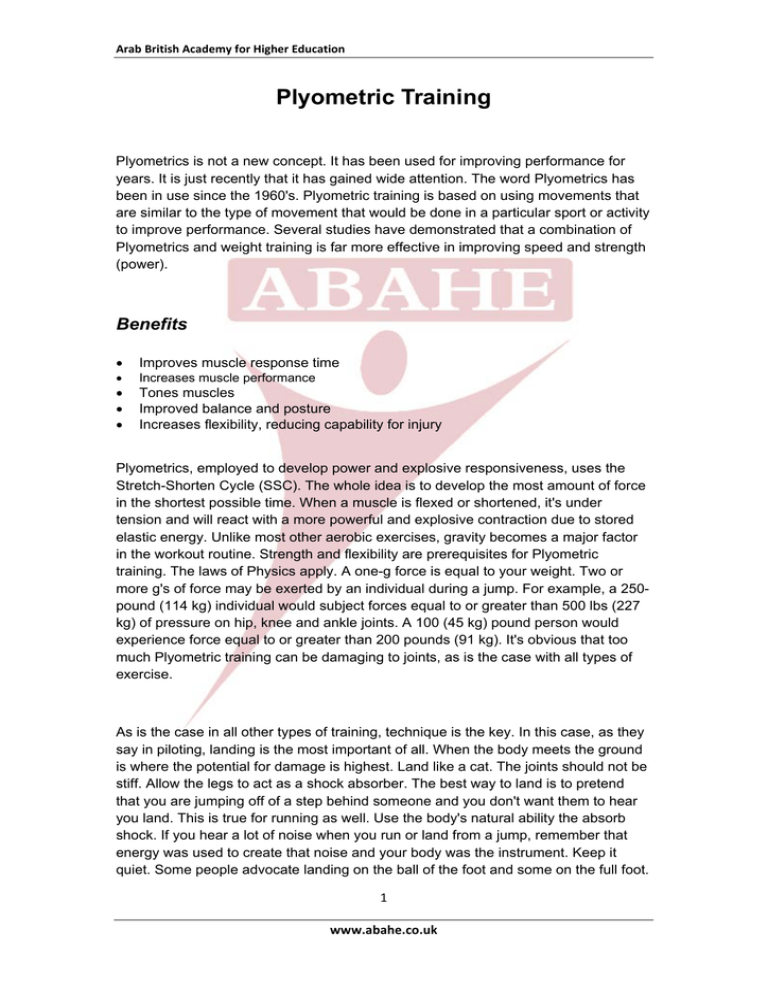
Arab British Academy for Higher Education Plyometric Training
Plyometrics is not a new concept. It has been used for improving performance for
years. It is just recently that it has gained wide attention. The word Plyometrics has
been in use since the 1960's. Plyometric training is based on using movements that
are similar to the type of movement that would be done in a particular sport or activity
to improve performance. Several studies have demonstrated that a combination of
Plyometrics and weight training is far more effective in improving speed and strength
(power).
Benefits
Improves muscle response time
Increases muscle performance
Tones muscles
Improved balance and posture
Increases flexibility, reducing capability for injury
Plyometrics, employed to develop power and explosive responsiveness, uses the
Stretch-Shorten Cycle (SSC). The whole idea is to develop the most amount of force
in the shortest possible time. When a muscle is flexed or shortened, it's under
tension and will react with a more powerful and explosive contraction due to stored
elastic energy. Unlike most other aerobic exercises, gravity becomes a major factor
in the workout routine. Strength and flexibility are prerequisites for Plyometric
training. The laws of Physics apply. A one-g force is equal to your weight. Two or
more g's of force may be exerted by an individual during a jump. For example, a 250pound (114 kg) individual would subject forces equal to or greater than 500 lbs (227
kg) of pressure on hip, knee and ankle joints. A 100 (45 kg) pound person would
experience force equal to or greater than 200 pounds (91 kg). It's obvious that too
much Plyometric training can be damaging to joints, as is the case with all types of
exercise.
As is the case in all other types of training, technique is the key. In this case, as they
say in piloting, landing is the most important of all. When the body meets the ground
is where the potential for damage is highest. Land like a cat. The joints should not be
stiff. Allow the legs to act as a shock absorber. The best way to land is to pretend
that you are jumping off of a step behind someone and you don't want them to hear
you land. This is true for running as well. Use the body's natural ability the absorb
shock. If you hear a lot of noise when you run or land from a jump, remember that
energy was used to create that noise and your body was the instrument. Keep it
quiet. Some people advocate landing on the ball of the foot and some on the full foot.
1 www.abahe.co.uk Arab British Academy for Higher Education Either way, energy must smoothly and evenly transfer up the leg. The use of arms in
a jump has been shown to contribute up to 10% of the jump results.
When a muscle is eccentrically contracted (stretched or elongated) and then
subsequently concentrically contracted (flexed or shortened) the speed of the
contraction is increased thereby creating a more powerful contraction similar to a
stretched rubber band. In the real world, muscles undergo a more complex
movement involving muscle groups and greater neural interaction than what can be
achieved in regular weight training.
There is some controversy as to whether plyometrics are safe. The question is
answered by moderation. All types of exercise can be damaging if done to excess or
just trying to do too much too soon. Start out small. Use low jumps until your body
becomes adapted for balance and timing. Unfortunately the stories come from people
just not willing to give their body a break, rest in between workouts and vary their
workouts. Running everyday is not good either. Unless you have joint problems,
Plyometrics is as safe as any other exercise and provides another area of physical
training.
All Rights Reserved © Arab British Academy for Higher Education 2 www.abahe.co.uk

